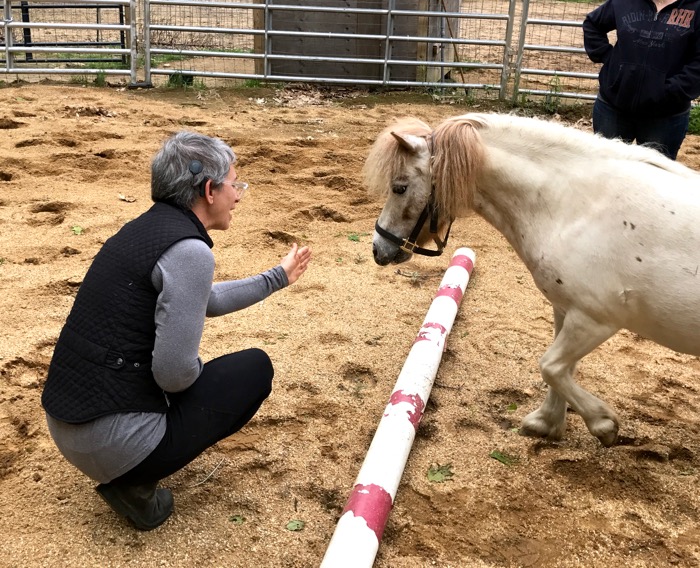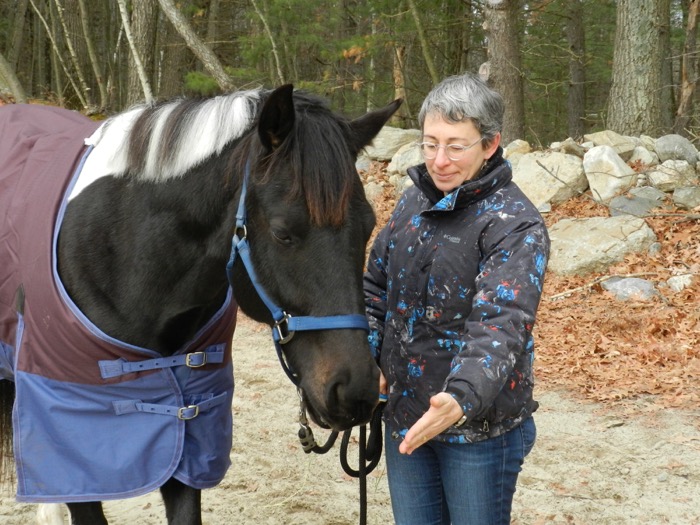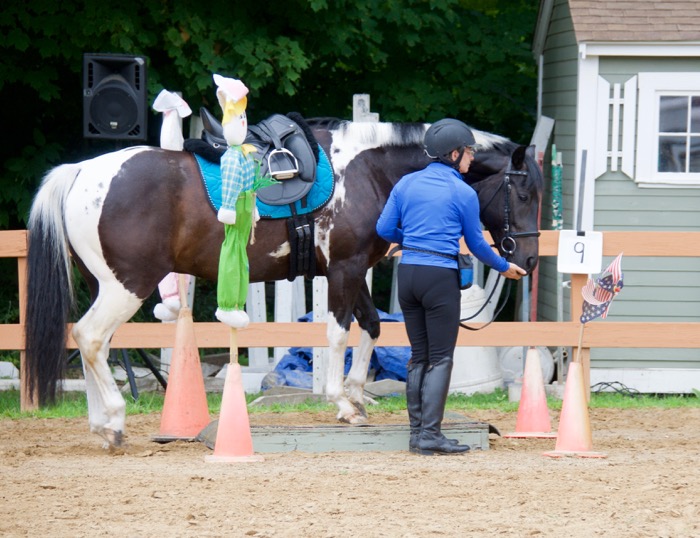We all have things that we’re afraid of. Some of those things we should be afraid of, and fear lets us take quick evasive action. But other things get in the way of life. (For example, if I let my fear of snakes control me, I’d never go into my backyard.) Horses are animals that survive by dashing off first, and then stopping at a distance to assess the situation. That dashing off can be a problem for us humans attached to our horses, either in the saddle or with a lead line! That dashing off can cause injury to both horse and owner. In our attempts to stop it, we often get into conflict with our animals, which can escalate to drama that causes both emotional and physical pain.
One way to train horses to be compliant is to teach them that nothing that they do has an effect. Behavioral scientists call this flooding. Tying a horse up and letting them fight it out against the rope, chasing a horse around and around a pen until they stop from exhaustion, throwing a saddle on a horse and letting them buck until they give up – these are all ways to get a horse to believe that moving away from danger doesn’t work. The problem is that there are many downsides to this sort of handling. The horse doesn’t act out of trust, but rather out of resignation. The training itself is scary and often painful, and the handler is associated with that. The horse becomes shut down. Dull. Many of the horses that I work with have gone through this. They seem obedient, but they have a snapping point, and I get called in because something has made them so fearful or angry that they explode.
There’s an alternative. One that teaches trust and bravery. And it all starts with a simple hand touch.
I teach the horse to gently touch my flat palm (held perpendicular to the ground) with their nose.

When the horse does that, I mark the moment of that soft touch with a word, or a quick “Dee!” That lets the horse know the exact behavior that I’m about to reward – and reward I do! Every touch gets a cookie. I soon add the word “touch” right before the nose reaches my hand. Soon the horse understands that the word “touch” is a cue to touch my hand, and that doing so results in something yummy. This behavior becomes so highly reinforcing to the horse that I can use it in a scary situation to overcome their fear.
This appaloosa mini (*take a second to appreciate the sheer adorableness of this horse and then keep reading!!!*) was afraid to step over poles. But the “touch” made him feel safe and capable. Even eager!

“Touch” was one of the first things that I taught Tonka when I got him four years ago.

Here we are at the beginning of the training. Tonka was shut down when I got him. Compliant but not connected.
See that light go on in his eyes?

I can then use the touch to get him to bravely walk over obstacles. Here we are at our first versatility competition. We hadn’t done any work at home to prepare. This was the first time he’d seen such things. Easy!

There’s a serious side to this training. There are times when we have to have a horse do something. There’s no time to train. I don’t want to revert to force, or a chain on the nose. I don’t want to have to make a withdrawal from my horse’s trust account with me. Last month I took Tonka to an animal hospital. After leading him into a building with noises, smells and sights that would make anyone nervous, I was directed to lead him onto the scale.
Not only did Tonka walk on, but I was able to put to use the “over” training that I’ve recently been working on. Looks easy, doesn’t it?
Watch the video again. Do you see that moment when Tonka hesitated slightly? That’s when I showed him my hand and asked for the “touch.” That’s why he’s so trusting.
By the way, my little horse weighed 1,133 pounds!


I don’t know what is wrong with me…my heart leaps when I see either a giant, roman nosed draft, especially one with a true gentle giant personality, or, a ridiculously small mini or pony. I owned a draft-TB cross many years ago, a 17.1 retired NYC police horse (the only grey ever in service, named Pasha) who was calm, clever, and utterly unafraid of anything, and yet still curious and very tuned in. And of course, my 9+ hand rescue pony Boo Boo, who could do anything but load a dishwasher, if just given a minute to work it out on his own. Without knowing what she was doing, Boo Boo’s tiny rider, Gracie, did exactly what you talk about in this post, only she had to do it from the saddle. Anything and everything scary was met with an encouraging cue word and rewarded instantly with much paper crinkling and peppermint giving. Who knew they were both geniuses? P.S. How pretty is Tonka calmly posing on the scale?
Nothing is wrong with you. I too love a Roman nose. Pasha sounds like perfection.
My big-boned 16hh mustang only weighs 100 or so more pounds than Tonka; how can that be???
I don’t know!!! I put a weight tape on him when I got him home, and it was also at 1100 pounds. Tonka isn’t fat, either. I can feel his ribs and he doesn’t have fat pads. One reason I purchased him was because I loved his short, sturdy cannon bones. Heavy bones? 🙂
Muscle weighs more than fat, Tonka is now well toned with possible quite a bit of muscle, this may account for the weight,
Wonderful blog as usual. Also a very big thank you for getting Hencam up and working again, I love checking in when I have lunch as your Girls are just getting up and I see them go to bed before I do. Have you still got all the Girls l never seem to be able to count more than 10, also is Phoebe still going strong. Thanks 🙂
We still have the 10 old hens. Phoebe is quite happy digging tunnels, which we then fill in to keep her in her enclosure. The Goat Boys are fine. Lily and Scooter are too 🙂
I think that the “touch” cue will be my next project. What a useful behavior to learn! Years ago, the training that I had done with one of my dogs was put to good use when she cut a small artery in her foot. I put her in a down stay on our deck while I gathered first aid supplies. She also knew “paw” so I bandaged her up while she held her paw out for me. In the car on the way to the vets, the “leave it” command told her not to worry the bandage. In the end, I didn’t have to clean up any blood in my house or car, and the vet was able to work with a calm dog and owner. Three simple commands made all the difference in this emergency!
Thank you for sharing this story. It’s what good training is all about. I taught my dog Nimbus, a “wait.” She’d stop on a dime, even when running free down a trail. It saved her life, once. We were on a new trail, and she was way up ahead, going full speed, when I realized that the trail was emptying onto a busy highway. There’s no reason not to train our horses similar behaviors.
Whew! You must have been so proud of Nimbus!
What a well behaved boy Tonker is. The video of him walking on the scale is lovely. I love the touch training.
Thanks, Carol. You could teach a chicken to “touch.” 🙂
I loved this. The trust is awesome.